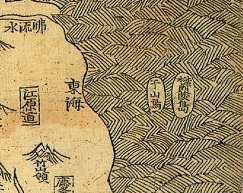
Year 512 (DXII) was a leap year starting on Sunday of the Julian calendar. In the Roman Empire,it was known as the Year of the Consulship of Paulus and Moschianus. The denomination 512 for this year has been used since the early medieval period,when the Anno Domini calendar era became the prevalent method in Europe for naming years.
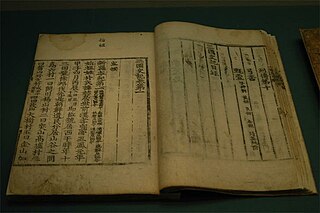
Samguk Sagi is a historical record of the Three Kingdoms of Korea:Goguryeo,Baekje,and Silla. Completed in 1145,it is well-known in Korea as the oldest surviving chronicle of Korean history.

The Three Kingdoms of Korea or Samguk competed for hegemony over the Korean Peninsula during the ancient period of Korean history. During the Three Kingdoms period,many states and statelets consolidated until,after Buyeo was annexed in 494 and Gaya was annexed in 562,only three remained on the Korean Peninsula:Goguryeo,Baekje and Silla. The "Korean Three Kingdoms" contributed to what would become Korea;and the Goguryeo,Baekje and Silla peoples became the Korean people.
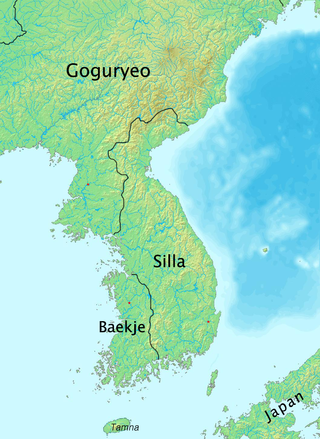
Silla,was a Korean kingdom that existed between 57 BCE –935 CE and located on the southern and central parts of the Korean Peninsula. Silla,along with Baekje and Goguryeo,formed the Three Kingdoms of Korea. Silla had the lowest population of approximately 850,000 people,which was significantly smaller than those of Baekje and Goguryeo.

Samguk yusa or Memorabilia of the Three Kingdoms is a collection of legends,folktales and historical accounts relating to the Three Kingdoms of Korea,as well as to other periods and states before,during and after the Three Kingdoms period. "Samguk yusa is a historical record compiled by the Buddhist monk Il-yeon in 1281 in the late Goryeo Dynasty." It is the earliest extant record of the Dangun legend,which records the founding of Gojoseon as the first Korean nation. The Samguk yusa is National Treasure No. 306.
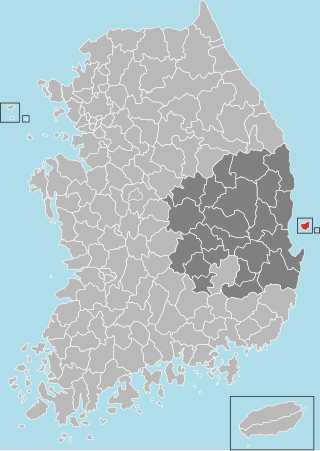
Ulleung County is a county in North Gyeongsang Province,South Korea.

Ulleungdo is a South Korean island 120 kilometres east of the Korean Peninsula in the Sea of Japan,formerly known as Dagelet Island or Argonaut Island in Europe. Volcanic in origin,the rocky steep-sided island is the top of a large stratovolcano which rises from the seafloor,reaching a maximum elevation of 984 metres (3,228 ft) at Seonginbong Peak. The island is 9.5 kilometres (6 mi) in length and ten kilometres (6 mi) in width;it has an area of 72.86 km2 (28.13 sq mi). It has a population of 10,426 inhabitants.

Tamna was a kingdom based on Jeju Island from ancient times until it was absorbed by the Korean Joseon dynasty in 1404,following a long period of being a tributary state or autonomous administrative region of various Korean kingdoms. The Go (Jeju) clan is the family name of the Lord,that ruled West Tamna over 400 years. The Moon (Nampyeong) clan is the family name of the Prince,that ruled East Tamna for 400 years.

Chumo,posthumously Chumo the Saint,was the founding monarch of the kingdom of Goguryeo,and was worshipped as a god-king by the people of Goguryeo and Goryeo. Chumo was originally a Buyeo slang for an excellent archer,which became his name later. He was commonly recorded as Jumong by various Chinese literatures including history books written by Northern Qi and Tang—the name became dominant in future writings including Samguk Sagi and Samguk Yusa. Chumo's title was changed to Dongmyeong the Saint,literally translated to the Brilliant Saintly King of the East,at some point of time prior to compilation of Samguk Sagi (1145). His other names include Chumong,Jungmo,Nakamu,or Tomo. In Samguk Sagi,he was recorded as Jumong with the surname Go,and was also known as Junghae or Sanghae.
Isabu was a military general and politician of Silla during the 6th century. According to Samguk Sagi,he is the fourth generation descendant of Naemul of Silla. He was also known as Taejong. He is best remembered today for his role in subjugating the island nation of Usan-guk. Usan-guk is the modern-day Ulleungdo,an island located in Sea of Japan. There is a dispute regarding his surname,as his family name is written as Kim in the Samguk Sagi. He was the 4th generation descendant of King Naemul,which also provides direct proof that his family name was Kim. But in Samguk Yusa,his name is Park I-Jong (朴伊宗).
Girim of Silla,whose name is sometimes given as Girip and also as Gigu,was the fifteenth king of Silla. The Samguk Sagi records that he was either the grandson or great-grandson of King Jobun. Though he and his father Seok Gul-suk had descended from the Park clan paternally,they were both recorded as Seoks due to their maternal Seok lineage.

Naemul of Silla was the 17th ruler of the Korean kingdom of Silla. He was the nephew of King Michu. He married Michu's daughter,Lady Boban. He is given the title Isageum,the same one borne by earlier rulers,in the Samguk Sagi;he is given the title Maripgan,borne by later rulers,in the Samguk Yusa. He is the first to bear the title Maripgan in any record.
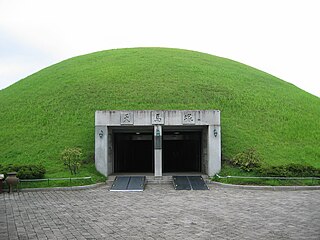
Jijeung of Silla (437–514) was the 22nd ruler of the Korean kingdom of Silla. He is remembered for strengthening royal authority and building Silla into a centralized kingdom.
The Haedong Goseungjeon was a compilation of mostly Korean Buddhist hagiographies,notably of famous monks from the Three Kingdoms period of Korean history.
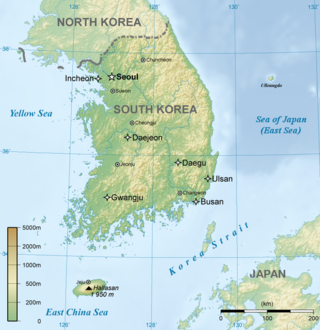
Jukdo is a small island adjacent to Ulleungdo,South Korea,in the east sea of Korea. It is also known as Jukseodo in Korea and Japan. It lies 2 km (1 mi) east of Ulleungdo,and is the largest island in the group apart from Ulleungdo itself. In 2004,one family of three members was living on the island.
Usan-do is a historical name for an island in the Sea of Japan described in Korean records. It was part of the ancient state of Usan-guk,but its exact identity is disputed. It may refer to:

The Liancourt Rocks,also known by their Korean name of Dokdo or their Japanese name of Takeshima,are a group of islets in the Sea of Japan between the Korean peninsula and the Japanese archipelago administered by South Korea. The Liancourt Rocks comprise two main islets and 35 smaller rocks;the total surface area of the islets is 0.187554 square kilometres and the highest elevation of 168.5 metres (553 ft) is on the West Islet. The Liancourt Rocks lie in rich fishing grounds that may contain large deposits of natural gas. The English name Liancourt Rocks is derived from Le Liancourt,the name of a French whaling ship that came close to being wrecked on the rocks in 1849.

An Yong-bok was a Korean fisherman in 17th century of Joseon Dynasty famous for his travels to Japan. His activities were instrumental in determining fishery rights in the waters of Ulleungdo and the Liancourt Rocks,two islands in the East Sea.

The Liancourt Rocks dispute,also called the Takeshima dispute or Dokdo dispute is a territorial dispute between South Korea and Japan regarding sovereignty over the Liancourt Rocks,a group of small islets in the Sea of Japan. The rocks also go by the names Dokdo and Takeshima. North Korea also claims sovereignty of the islands,but has not pursued its claim to the same extent as the other parties.
Lady Jukbang of the Juksan Bak clan,was a Silla royal family as the descendant of King Pasa and primary wife of King Gyeongsun,making her the last Silla queen consort.

